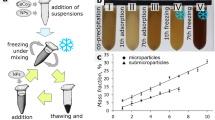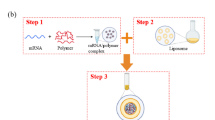Abstract
Purpose. The goal of the present paper was to encapsulateoligonucleotides in a new particulate carrier in order to protect them fromenzymatic degradation.
Methods. Nanocapsules with an aqueous core containingoligonucleotides were prepared by interfacial polymerization ofisobutylcyanoacry late in a W/O emulsion. Ultracentrifugation and re-suspensionin water yielded a dispersion of these containing an aqueous core nanocapsules.Zeta potential measurements and quenching of fluorescence offluorescein-bounded oligonucleotides were used to study the localization ofthe oligonucleotides. Oligonucleotide degradation studies were carriedout in fetal calf serum.
Results. Polydisperse nanocapsules of size ranging from 20 to 400 nmwere obtained. Oligonucleotide loading did not significantly influencethe zeta potential, suggesting they were located within the core of thenanocapsules. Fluorescence quenching assays confirmed thislocalization. When encapsulated in the nanocapsules and incubated in thepresence of serum, the oligonucleotides were efficiently protected fromdegradation by nucleases, whereas oligonucleotides adsorbed ontonanospheres were protected less efficiently.
Conclusions. This paper describes, for the first time, ananotechnologyable to encapsulate oligonucleotides rather than adsorbing them at thesurface of a solid support. Such a formulation has great potential foroligonucleotide delivery.
Similar content being viewed by others
REFERENCES
P. Guinot and J. Temsamani. Antisense oligonucleotides: a new therapeutic approach. Pathol. Biol. (Paris) 46:347–54 (1998).
N. Dean, R. McKay, L. Miraglia, R. Howard, S. Cooper, J. Giddings, P. Nicklin, L. Meister, R. Ziel, T. Geiger, M. Muller, and D. Fabbro. Inhibition of growth of human tumor cell lines in nude mice by an antisense of oligonucleotide inhibitor of protein kinase C-alpha expression. Cancer Res. 56:3499–3507 (1996).
T. Geiger, M. Muller, N. M. Dean, and D. Fabbro. Antitumor activity of a PKC-alpha antisense oligonucleotide in combination with standard chemotherapeutic agents against various human tumors transplanted into nude mice. Anticancer Drug Des. 13: 35–45 (1998).
K. Yamaguchi, B. Papp, D. Zhang, A. N. Ali, S. Agrawal, and R. A. Byrn. The multiple inhibitory mechanisms of GEM 91, a gag antisense phosphorothioate oligonucleotide, for human immunodeficiency virus type 1. AIDS Res. Hum. Retroviruses 13:545–554 (1997).
Y. S. Lee, A. A. Dlugosz, R. McKay, N. M. Dean, and S. H. Yuspa. Definition by specific antisense oligonucleotides of a role for protein kinase C alpha in expression of differentiation markers in normal and neoplastic mouse epidermal keratinocytes. Mol. Carninog. 18:44–53 (1997).
R. L. Juliano, S. Alahari, H. Yoo, R. Kole, and M. Cho. Antisense pharmacodynamics: critical issues in the transport and delivery of antisense oligonucleotides. Pharm. Res. 16:494–502 (1999).
A. De Mesmaeker, K. H. Altmann, A. Waldner, and S. Wendeborn. Backbone modifications in oligonucleotides and peptide nucleic acid systems. Curr. Opin. Struct. Biol. 5:343–355 (1995).
A. M. Krieg and C. A. Stein. Phosphorothioate oligodeoxynucleotides: antisense or anti-protein? Antisense Res. Dev. 5:241 (1995).
C. A. Stein. Phosphorothioate antisense oligodeoxynucleotides: questions of specificity. Biotechnol. 14:47–149 (1996).
L. E. Black, J. G. Farrelly, J. A. Cavagnaro, C. H. Ahn, J. J. DeGeorge, A. S. Taylor, A. F. DeFelice and A. Jordan. Regulatory considerations for oligonucleotide drugs: updated recommendations for pharmacology and toxicology studies. Antisense Res. Dev. 4:299–301 (1994).
D. K. Monteith and A. A. Levin. Synthetic oligonucleotides: the development of antisense therapeutics. Toxicol. Pathol. 27: 8–13 (1999).
E. Fattal, C. Vauthier, I. Aynie, Y. Nakada, G. Lambert, C. Malvy, and P. Couvreur. Biodegradable polyalkylcyanoacrylate nanoparticles for the delivery of oligonucleotides. J. Contr. Rel. 53:137–43 (1998).
I. Aynie, C. Vauthier, H. Chacun, E. Fattal, and P. Couvreur. Spongelike alginate nanoparticles as a new potential system for the delivery of antisense oligonucleotides. Antisense Nucleic Acid Drug Dev. 9:301–12 (1999).
C. Chavany, T. Le Doan, P. Couvreur, F. Puisieux, and C. Helene. Polyalkylcyanoacrylate nanoparticles as polymeric carriers for antisense oligonucleotides. Pharm. Res. 9:441–449 (1992).
Y. Nakada, E. Fattal, M. Foulquier, and P. Couvreur. Pharmacokinetics and biodistribution of oligonucleotide adsorbed onto poly(isobutylcyanoacrylate) nanoparticles after intravenous administration in mice. Pharm. Res. 13:38–43 (1996).
F. Ganachaud, A. Elaissari, C. Pichot, A. Laayoun, and P. Cros. Adsorption of single-strand DNA fragments onto cationic aminated latex particles. Langmuir 13:701–707 (1997).
H. Fessi, F. Puisieux, J. P. Devissaguet, N. Ammoury, and S. Benita. Nanocapsules formation by interfacial polymer deposition following solvent displacement. Int. J. Pharm. 55:R1–R4 (1989).
D. Quintanar-Guerrero, E. Allemann, E. Doelker, and H. Fessi. Preparation and characterization of nanocapsules from preformed polymers by a new process based on emulsification-diffusion technique. Pharm. Res. 15:1056–62 (1998).
N. Al Khouri Fallouh, L. Roblot-Treupel, H. Fessi, J. P. Devissaguet, and F. Puisieux. Development of a new process for the manufacture of polyisobutylcyanoacrylate nanocapsules. Int. J. Pharm. 28:125–132 (1986).
H. Vranckx, M. Demoustier, and M. Deleers. A New Nanocapsule Formulation with Hydrophilic Core: Application to the Oral Administration of Salmon Calcitonin in Rats. Eur. J. Pharm. Biopharm. 42:345–347 (1996).
I. Aynie, C. Vauthier, M. Foulquier, C. Malvy, E. Fattal, and P. Couvreur. Development of a quantitative polyacrylamide gel electrophoresis analysis using a multichannel radioactivity counter for the evaluation of oligonucleotide-bound drug carrier. Anal. Biochem. 240:202–209 (1996).
G. Lambert, E. Fattal, A. Brehier, J. Feger, and P. Couvreur. Effect of polyisobutylcyanoacrylate nanoparticles and lipofectin loaded with oligonucleotides on cell viability and PKC alpha neosynthesis in HepG2 cells. Biochimie 80:969–76 (1998).
S. S. Lehrer. Solute perturbation of protein fluorescence. The quenching of the tryptophyl fluorescence of model compounds and of lysozyme by iodide ion. Biochemistry 10:3254–63 (1971).
R. M. Watt and E. W. Voss, Jr. Solvent perturbation of the fluorescence of fluorescein bound to specific antibody. Fluorescence quenching of the bound fluorophore by iodide. J. Biol. Chem. 254:1684–90 (1979).
R. H. Muller, C. Lherm, J. Herbort, and P. Couvreur. In vitro model for the degradation of alkylcyanoacrylate nanoparticles. Biomaterials 11:590–595 (1990).
V. Lenaerts, P. Couvreur, D. Christiaens-Leyh, E. Joiris, M. Roland, B. Rollman, and P. Speiser. Degradation of poly (isobutyl cyanoacrylate) nanoparticles. Biomaterials 5:65–68 (1984).
C. Chavany, T. Saison-Behmoaras, T. Le Doan, F. Puisieux, P. Couvreur, and C. Helene. Adsorption of oligonucleotides onto polyisohexylcyanoacrylate nanoparticles protects them against nucleases and increases their cellular uptake. Pharm. Res. 11:1370–1378 (1994).
G. Schwab, C. Chavany, I. Duroux, G. Goubin, J. Lebeau, C. Helene, and T. Saison-Behmoaras. Antisense oligonucleotides adsorbed to polyalkylcyanoacrylate nanoparticles specifically inhibit mutated Ha-ras-mediated cell proliferation and tumorigenicity in nude mice. Proc. Natl. Acad. Sci. U.S.A. 91:10460–10464 (1994).
R. Chakraborty, D. Dasgupta, S. Adhya, and M. K. Basu. Cationic liposome-encapsulated antisense oligonucleotide mediates efficient killing of intracellular Leishmania. Biochem. J. 340: 393–6 (1999).
P. Couvreur, B. Kante, M. Roland, and P. Speiser. Adsorption of antineoplastic drugs to polyalkylcyanoacrylate nanoparticles and their release in calf serum. J. Pharm. Sci. 68:1521–1524 (1979).
Author information
Authors and Affiliations
Rights and permissions
About this article
Cite this article
Lambert, G., Fattal, E., Pinto-Alphandary, H. et al. Polyisobutylcyanoacrylate Nanocapsules Containing an Aqueous Core as a Novel Colloidal Carrier for the Delivery of Oligonucleotides. Pharm Res 17, 707–714 (2000). https://doi.org/10.1023/A:1007582332491
Issue Date:
DOI: https://doi.org/10.1023/A:1007582332491




